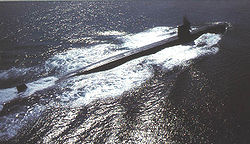Portal:Submarine
The Submarine PortalA submarine is a watercraft capable of independent operation below the surface of the water. It differs from a submersible, which has only limited underwater capability. The term submarine most commonly refers to large crewed autonomous vessels; however, historically or more casually, submarine can also refer to medium sized or smaller vessels (midget submarines, wet subs), remotely operated vehicles or robots. The word submarine was originally an adjective meaning "under the sea", and so consequently other uses such as "submarine engineering" or "submarine cable" may not actually refer to submarines at all. Submarine was shortened from the term "submarine boat", and is often further shortened to "sub". Submarines are referred to as "boats" rather than as "ships", regardless of their size. The English term U-boat for a German submarine comes from the German word for submarine, U-Boot, itself an abbreviation for Unterseeboot ("undersea boat"). Submarine history goes back far before the 19th century, in the form of some experimental boats, submarine design began to gear up during the 19th century. Submarines were first widely used in World War I, and feature in many large navies. Uses in submarine warfare range from attacking enemy ships or submarines, aircraft carrier protection, blockade running, ballistic missile submarines as part of a nuclear strike force, reconnaissance, conventional land attack (for example using a cruise missile), and covert insertion of special forces. Civilian uses for submarines include marine science, salvage, exploration and facility inspection/maintenance. Submarines can also be specialized to a function such as search and rescue, or undersea cable repair. Submarines are also used in tourism and for academic research. Submarines have one of the largest ranges of capabilities in any vessel, ranging from small autonomous examples to one or two-person vessels operating for a few hours, to vessels which can remain submerged for 6 months such as the Russian Typhoon class. Submarines can work at greater depths than are survivable or practical for human divers. Modern deep diving submarines are derived from the bathyscaphe, which in turn was an evolution of the diving bell. Most large submarines comprise a cylindrical body with hemispherical (and/or conical) ends and a vertical structure, usually located amidships, which houses communications and sensing devices as well as periscopes. In modern submarines this structure is the "sail" in American usage, and "fin" in European usage. A "conning tower" was a feature of earlier designs: a separate pressure hull above the main body of the boat that allowed the use of shorter periscopes. There is a propeller (or pump jet) at the rear and various hydrodynamic control fins as well as ballast tanks. Smaller, deep diving and specialty submarines may deviate significantly from this traditional layout. Selected article
Selected biography
Selected pictureThe Los Angeles class, sometimes called the LA class or the 688 class, is a class of nuclear-powered fast attack submarines (SSN) that forms the backbone of the United States submarine fleet. In the news
CategoriesThings to do
To transclude this list, use {{Wikipedia:WikiProject Military history/Incubator/Submarines/Open tasks}} Related portalsShowcaseNone at present Ehime Maru and USS Greeneville collision • Nyon Conference • SM U-66 SM U-14 (Austria-Hungary) • SM UB-10 • SM UB-14 • SM UB-16 • SM UB-43 • SM UB-45 • USS Triton (SSRN-586) German Type IXA submarines • German Type U 66 submarines • German Type UB I submarines • U-20 class submarines • U-27 class submarines (Austria-Hungary) • U-3 class submarines • U-43 class submarines (Austria-Hungary) • U-5 class submarines British B class submarine • German submarine U-104 (1940) • German submarine U-105 (1940) • German submarine U-111 (1940) • German submarine U-162 (1941) • German submarine U-2336 • German submarine U-255 • German submarine U-27 (1936) • German submarine U-28 (1936) • German submarine U-30 (1936) • German submarine U-36 (1936) • German submarine U-37 (1938) • German submarine U-38 (1938) • German submarine U-39 (1938) • German submarine U-40 (1938) • German submarine U-41 (1939) • German submarine U-42 (1939) • German submarine U-43 (1939) • German submarine U-47 (1938) • German submarine U-64 (1939) • German submarine U-853 • German Type IXA submarine • German Type UB I submarine • German U-boat bases in occupied Norway • HMS Phoenix (N96) • HMS Trump (P333) • HMS X1 • Russian submarine B-585 Saint Petersburg • Russian submarine K-114 Tula • SM U-27 (Austria-Hungary) • SM U-28 (Austria-Hungary) • SM U-30 (Austria-Hungary) • SM U-31 (Austria-Hungary) • SM U-32 (Austria-Hungary) • SM U-40 (Austria-Hungary) • SM U-41 (Austria-Hungary) • SM UB-11 • SM UB-12 • SM UB-13 • SM UB-17 • SM UB-2 • SM UB-3 • SM UB-4 • SM UB-42 • SM UB-44 • SM UB-47 • SM UB-50 • SM UB-6 • SM UB-7 • SM UB-8 • SM UB-9 • Turtle (submersible) Wikimedia
|








